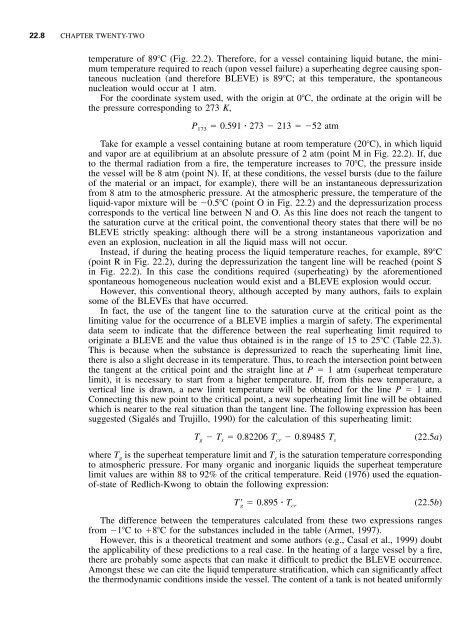CHAPTER 22 MODELING AND UNDERSTANDING BLEVEs
CHAPTER 22 MODELING AND UNDERSTANDING BLEVEs
CHAPTER 22 MODELING AND UNDERSTANDING BLEVEs
Create successful ePaper yourself
Turn your PDF publications into a flip-book with our unique Google optimized e-Paper software.
<strong>22</strong>.8 <strong>CHAPTER</strong> TWENTY-TWO<br />
temperature of 89�C (Fig. <strong>22</strong>.2). Therefore, for a vessel containing liquid butane, the minimum<br />
temperature required to reach (upon vessel failure) a superheating degree causing spontaneous<br />
nucleation (and therefore BLEVE) is 89�C; at this temperature, the spontaneous<br />
nucleation would occur at 1 atm.<br />
For the coordinate system used, with the origin at 0�C, the ordinate at the origin will be<br />
the pressure corresponding to 273 K,<br />
P173 � 0.591 � 273 � 213 ��52 atm<br />
Take for example a vessel containing butane at room temperature (20�C), in which liquid<br />
and vapor are at equilibrium at an absolute pressure of 2 atm (point M in Fig. <strong>22</strong>.2). If, due<br />
to the thermal radiation from a fire, the temperature increases to 70�C, the pressure inside<br />
the vessel will be 8 atm (point N). If, at these conditions, the vessel bursts (due to the failure<br />
of the material or an impact, for example), there will be an instantaneous depressurization<br />
from 8 atm to the atmospheric pressure. At the atmospheric pressure, the temperature of the<br />
liquid-vapor mixture will be �0.5�C (point O in Fig. <strong>22</strong>.2) and the depressurization process<br />
corresponds to the vertical line between N and O. As this line does not reach the tangent to<br />
the saturation curve at the critical point, the conventional theory states that there will be no<br />
BLEVE strictly speaking: although there will be a strong instantaneous vaporization and<br />
even an explosion, nucleation in all the liquid mass will not occur.<br />
Instead, if during the heating process the liquid temperature reaches, for example, 89�C<br />
(point R in Fig. <strong>22</strong>.2), during the depressurization the tangent line will be reached (point S<br />
in Fig. <strong>22</strong>.2). In this case the conditions required (superheating) by the aforementioned<br />
spontaneous homogeneous nucleation would exist and a BLEVE explosion would occur.<br />
However, this conventional theory, although accepted by many authors, fails to explain<br />
some of the <strong>BLEVEs</strong> that have occurred.<br />
In fact, the use of the tangent line to the saturation curve at the critical point as the<br />
limiting value for the occurrence of a BLEVE implies a margin of safety. The experimental<br />
data seem to indicate that the difference between the real superheating limit required to<br />
originate a BLEVE and the value thus obtained is in the range of 15 to 25�C (Table <strong>22</strong>.3).<br />
This is because when the substance is depressurized to reach the superheating limit line,<br />
there is also a slight decrease in its temperature. Thus, to reach the intersection point between<br />
the tangent at the critical point and the straight line at P � 1 atm (superheat temperature<br />
limit), it is necessary to start from a higher temperature. If, from this new temperature, a<br />
vertical line is drawn, a new limit temperature will be obtained for the line P � 1 atm.<br />
Connecting this new point to the critical point, a new superheating limit line will be obtained<br />
which is nearer to the real situation than the tangent line. The following expression has been<br />
suggested (Sigalés and Trujillo, 1990) for the calculation of this superheating limit:<br />
T � T � 0.8<strong>22</strong>06 T � 0.89485 T (<strong>22</strong>.5a)<br />
g s cr s<br />
where T g is the superheat temperature limit and T s is the saturation temperature corresponding<br />
to atmospheric pressure. For many organic and inorganic liquids the superheat temperature<br />
limit values are within 88 to 92% of the critical temperature. Reid (1976) used the equationof-state<br />
of Redlich-Kwong to obtain the following expression:<br />
T� � 0.895 � T (<strong>22</strong>.5b)<br />
g cr<br />
The difference between the temperatures calculated from these two expressions ranges<br />
from �1�C to�8�C for the substances included in the table (Armet, 1997).<br />
However, this is a theoretical treatment and some authors (e.g., Casal et al., 1999) doubt<br />
the applicability of these predictions to a real case. In the heating of a large vessel by a fire,<br />
there are probably some aspects that can make it difficult to predict the BLEVE occurrence.<br />
Amongst these we can cite the liquid temperature stratification, which can significantly affect<br />
the thermodynamic conditions inside the vessel. The content of a tank is not heated uniformly

















